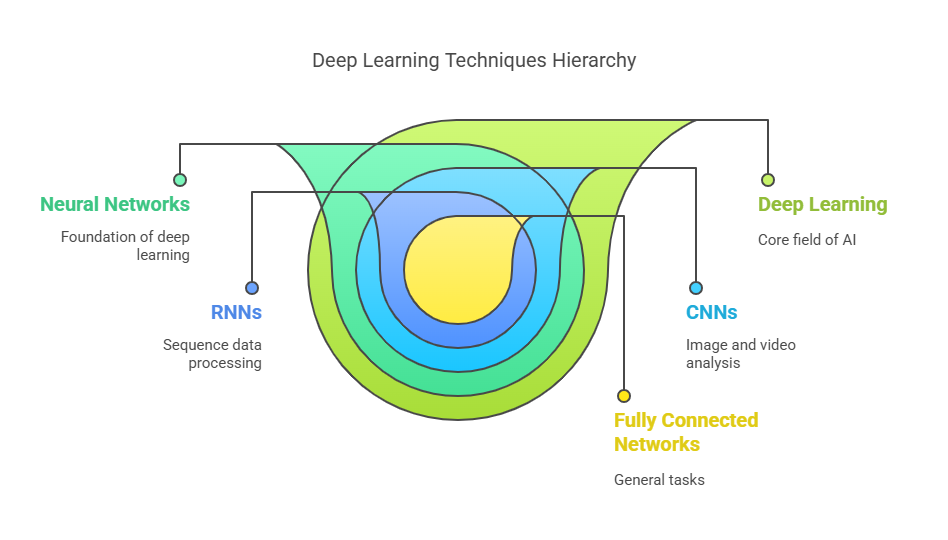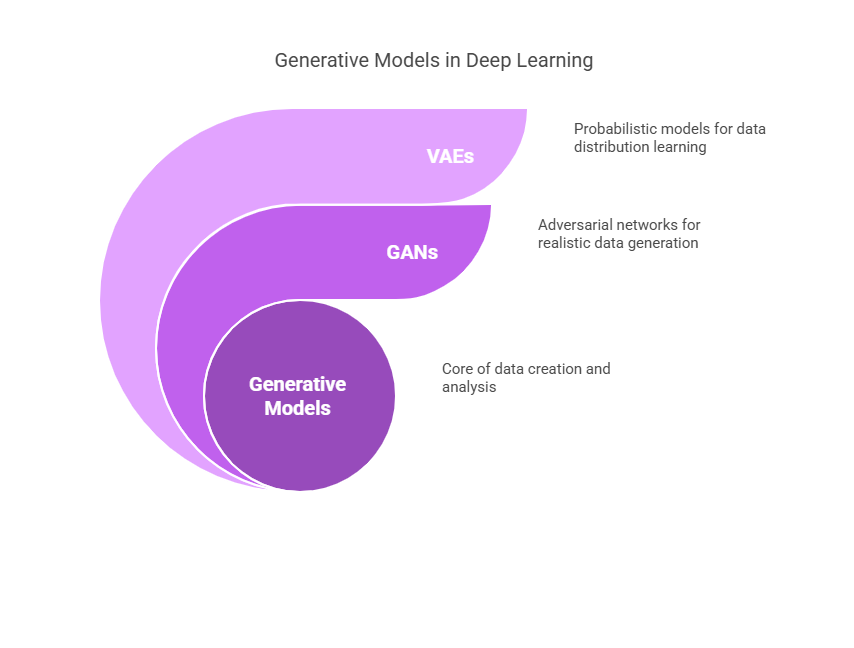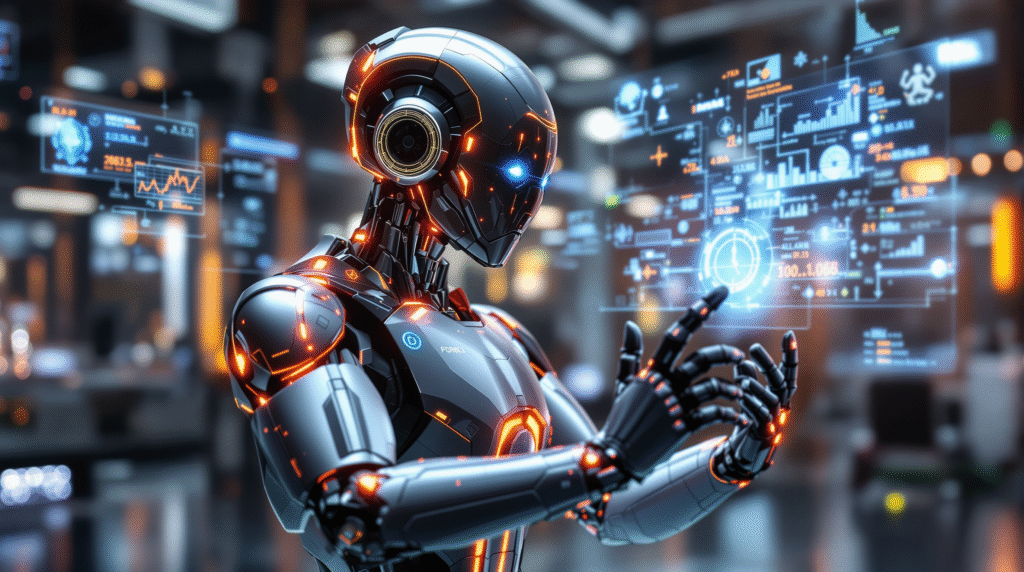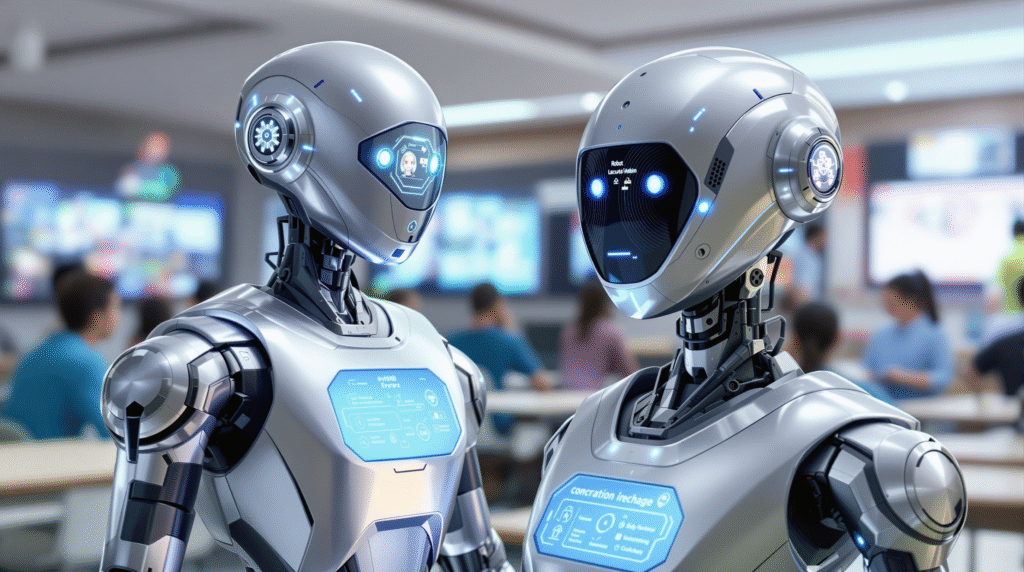Introduction to Advanced Deep Learning Techniques
Deep learning is a field of artificial intelligence that has revolutionized many areas of technology in recent years, such as image recognition, natural language processing, and content generation. As this field has evolved, increasingly advanced techniques have emerged, enabling the construction of even more effective and flexible models. In this section, we will review the basics of deep learning and explain why advanced techniques are essential today.
1.1. A Brief Review of Deep Learning Basics
Deep learning is based on artificial neural networks, which consist of many layers (hence the term „deep”). Each layer processes the input data and passes it on, allowing the model to gradually extract increasingly complex features. The most popular types of neural networks include:
Convolutional Neural Networks (CNNs) – mainly used in image and video analysis, they enable automatic detection of important features in visual data.
Recurrent Neural Networks (RNNs) – used for processing sequences such as text or time series data, allowing the modeling of temporal dependencies.
Fully Connected (Dense) Networks – classic neural network layers used in many classification and regression tasks.
The primary goal of deep learning is to teach the model data representations that allow it to effectively solve complex problems, such as object recognition in images or text translation.
Example code for building a simple neural network in Python using Keras:
python
import tensorflow as tf
from tensorflow.keras import layers, models
# Simple network for image classification
model = models.Sequential([
layers.Flatten(input_shape=(28, 28)),
layers.Dense(128, activation='relu'),
layers.Dense(10, activation='softmax')
])
model.compile(optimizer='adam',
loss='sparse_categorical_crossentropy',
metrics=['accuracy'])
print(model.summary())
1.2. Why Are Advanced Techniques Needed?
As the amount of data and the complexity of problems have increased, traditional neural network architectures have started to encounter limitations. These challenges include:
Problems with learning long-term dependencies – classic RNNs struggle to remember information over longer sequences.
High computational requirements – training large models on massive datasets requires advanced optimization techniques and resource management.
Overfitting and generalization – the larger the model, the greater the risk of overfitting, so effective regularization methods are needed.
The need for interpretability – complex models are often „black boxes,” making their deployment difficult in environments that require explainability.
Advanced techniques, such as the Transformer architecture, generative models (GANs, VAEs, Diffusion Models), and modern optimization and regularization methods, help overcome these limitations. Thanks to them, it is possible to build models that not only achieve better results but are also more scalable, efficient, and easier to deploy in practice.
Transformers – A Revolution in Sequence Processing
In recent years, the Transformer architecture has revolutionized the approach to sequence processing, both in natural language tasks and in image or audio analysis. Transformers have become the foundation of modern AI models such as BERT, GPT, and Vision Transformer (ViT). In this part of the article, we will discuss what Transformers are, how the Attention mechanism works, and what their applications are.
2.1. Transformer Architecture
The Transformer architecture was introduced in 2017 by a Google research team in the paper „Attention is All You Need.” Unlike earlier recurrent neural networks (RNNs), Transformers do not process data sequentially but in parallel, which significantly speeds up training and enables better model scaling.
The main components of the Transformer architecture are:
Encoder and decoder layers – the encoder processes the input data, while the decoder generates the output (e.g., text translation).
Attention mechanism – allows the model to „focus” on important parts of the sequence during processing.
Normalization and feed-forward layers – stabilize learning and increase the model’s capabilities.
The operation of a Transformer can be summarized as follows:
Input data is first converted into vectors (embeddings), then passed through successive encoder layers, where each layer applies the Attention mechanism and processes data in parallel. The decoder works similarly, generating output based on the encoded information.
2.2. Attention Mechanism
The key element of the Transformer is the Attention mechanism, specifically „self-attention.” This allows the model to dynamically assign different weights to individual elements of the sequence during processing.
In practice, this means the model can „pay attention” to different words in a sentence depending on the context, which significantly improves the quality of generated responses or translations.
Example implementation of the Attention mechanism in Python (TensorFlow):
python
import tensorflow as tf
def scaled_dot_product_attention(q, k, v):
matmul_qk = tf.matmul(q, k, transpose_b=True)
dk = tf.cast(tf.shape(k)[-1], tf.float32)
scaled_attention_logits = matmul_qk / tf.math.sqrt(dk)
attention_weights = tf.nn.softmax(scaled_attention_logits, axis=-1)
output = tf.matmul(attention_weights, v)
return output, attention_weights2.3. Applications of Transformers (NLP, Computer Vision)
Transformers were initially designed for natural language processing, but their versatility has led to applications in other fields as well.
Natural Language Processing (NLP):
Models such as BERT, GPT, T5, and RoBERTa achieve state-of-the-art results in tasks like translation, text generation, sentiment analysis, and question answering. Thanks to the Attention mechanism, they can better understand context and relationships in text.
Computer Vision:
The Vision Transformer (ViT) architecture brought the Transformer concept to image analysis by dividing an image into patches and treating them as a sequence. This approach has achieved results comparable to or better than classic convolutional neural networks in image classification tasks.
Other applications:
Transformers are also used in audio analysis, bioinformatics, and even in computer games for strategy generation.
Generative Models – From GANs to Diffusion Models
Generative models are one of the most fascinating and rapidly developing branches of deep learning. They allow not only for the analysis and classification of data but also for their creation—generating images, texts, sounds, or even DNA sequences. In this part of the article, we will look at the three most important types of generative models: GANs, VAEs, and Diffusion Models.
3.1. Generative Adversarial Networks (GAN)
Generative Adversarial Networks (GANs) are an architecture proposed by Ian Goodfellow in 2014. They consist of two neural networks: a generator and a discriminator, which compete with each other in a zero-sum game.
The generator tries to create data that is indistinguishable from real data.
The discriminator evaluates whether the data comes from the real dataset or was generated.
This process leads to the gradual improvement of both networks until the generator starts producing highly realistic data. GANs have found applications in image generation, deepfakes, image stylization, and reconstruction of missing data fragments.
Example code for a simplified GAN generator in Keras:
python
from tensorflow.keras import layers, models
def build_generator(latent_dim):
model = models.Sequential([
layers.Dense(128, activation='relu', input_dim=latent_dim),
layers.Dense(784, activation='sigmoid')
])
return model
generator = build_generator(100)
generator.summary()3.2. Variational Autoencoders (VAE)
Variational Autoencoders (VAEs) are probabilistic generative models that learn the probability distribution of input data. They consist of two main parts:
Encoder – encodes input data into a latent (hidden) space.
Decoder – reconstructs data based on the latent representation.
VAEs differ from classic autoencoders in that, instead of a single point in the latent space, they learn a distribution (most often normal), from which new points can be sampled to generate new data. Thanks to this, VAEs are used for image generation, style interpolation, and data compression.
Example code snippet for a VAE encoder:
python
from tensorflow.keras import layers, Model
latent_dim = 2
# Encoder
inputs = layers.Input(shape=(28, 28, 1))
x = layers.Flatten()(inputs)
x = layers.Dense(128, activation='relu')(x)
z_mean = layers.Dense(latent_dim)(x)
z_log_var = layers.Dense(latent_dim)(x)
encoder = Model(inputs, [z_mean, z_log_var])
encoder.summary()
3.3. Diffusion Models and Their Advantages
Diffusion Models are the latest generation of generative models, which have gained enormous popularity thanks to spectacular results in image generation (e.g., DALL-E 2, Stable Diffusion). Their operation is based on gradually adding noise to data and then „denoising” it to generate new samples.
Forward process: noise is gradually added to the input data until pure noise is obtained.
Reverse process: the model learns to reverse this process, generating realistic data from random noise.
Diffusion Models are more stable in training than GANs and allow for greater control over the generated data. As a result, they are used in image and sound generation, and even in molecule synthesis.
Example pseudocode for the denoising process:
# Pseudocode for the reverse process in a Diffusion Model
for t in reversed(range(T)):
x_t = denoise(x_t, t)Advanced Optimization and Regularization Techniques
As the complexity of deep learning models increases, the importance of effective optimization and regularization techniques also grows. These methods not only speed up and stabilize the training process but also improve the model’s ability to generalize and help prevent overfitting. In this part of the article, we will discuss the most important optimizers, regularization methods, and transfer learning and fine-tuning techniques.
4.1. Optimizers (Adam, RMSprop, LAMB)
Optimizers are algorithms that control the learning process of a neural network by updating its weights based on the calculated gradient. Modern optimizers are much more advanced than the classic Stochastic Gradient Descent (SGD).
Adam (Adaptive Moment Estimation):
One of the most popular optimizers, Adam combines the advantages of RMSprop and momentum. It automatically adjusts the learning rate for each weight, which speeds up convergence and stabilizes training.
RMSprop:
An optimizer that maintains a separate learning rate for each weight, based on the moving average of squared gradients. It is particularly effective for sequential data.
LAMB (Layer-wise Adaptive Moments):
A modern optimizer designed for training very large models on large datasets. It enables efficient scaling of training across multiple GPUs.
Example of using the Adam optimizer in Keras:
python
from tensorflow.keras.optimizers import Adam
model.compile(optimizer=Adam(learning_rate=0.001),
loss='categorical_crossentropy',
metrics=['accuracy'])4.2. Regularization (Dropout, BatchNorm, LayerNorm)
Regularization is a set of techniques that help prevent model overfitting, which occurs when a model learns the training data too specifically and loses its ability to generalize.
Dropout:
Involves randomly „turning off” some neurons during training, which forces the network to learn more general representations.
Batch Normalization (BatchNorm):
Normalizes the input data to each layer, which speeds up and stabilizes training and allows for higher learning rates.
Layer Normalization (LayerNorm):
Similar to BatchNorm, but normalizes data within a single sample rather than across the entire batch. It is especially effective in sequential models and Transformers.
Example of using Dropout and BatchNorm in Keras:
python
from tensorflow.keras import layers, models
model = models.Sequential([
layers.Dense(128, activation='relu', input_shape=(784,)),
layers.BatchNormalization(),
layers.Dropout(0.5),
layers.Dense(10, activation='softmax')
])4.3. Transfer Learning and Fine-Tuning
Transfer learning is a technique in which a model trained on a large, general dataset is used as a starting point for solving more specific tasks. This can significantly shorten training time and improve results, especially when you have a limited amount of data.
Transfer learning:
Involves „freezing” some layers of the pre-trained model and adding new layers that are trained on the new task.
Fine-tuning:
After initially training the new layers, you can „unfreeze” some of the original layers and continue training the entire model on the new dataset, adapting it to the specific task.
Example of transfer learning using a pre-trained ResNet50 model in Keras:
python
from tensorflow.keras.applications import ResNet50
from tensorflow.keras import layers, models
base_model = ResNet50(weights='imagenet', include_top=False, input_shape=(224, 224, 3))
base_model.trainable = False # Freeze weights
model = models.Sequential([
base_model,
layers.GlobalAveragePooling2D(),
layers.Dense(10, activation='softmax')
])Practical Challenges and Best Practices
Deploying advanced deep learning models in a production environment comes with many challenges. The right approach to scaling, resource management, as well as monitoring and interpreting models, is crucial for the success of AI projects. In this part of the article, we will discuss the most important practical aspects of working with large models.
5.1. Scaling Models and Training on Large Datasets
As the size of models and datasets increases, challenges related to performance and computational costs arise. Scaling models requires the use of appropriate strategies:
Distributed training:
Using multiple GPUs or compute clusters allows for parallel data processing and speeds up training. Popular frameworks such as TensorFlow and PyTorch offer support for distributed learning.
Memory optimization:
Techniques such as mixed precision training (training with 16-bit floating-point precision) help reduce memory usage and speed up computations without sacrificing model quality.
Efficient data management:
Efficient data loading and processing (e.g., using tf.data or DataLoader in PyTorch) minimizes downtime and allows full utilization of hardware resources.
Example of distributed training in TensorFlow:
import tensorflow as tf
strategy = tf.distribute.MirroredStrategy()
with strategy.scope():
model = tf.keras.models.Sequential([
tf.keras.layers.Dense(128, activation='relu', input_shape=(784,)),
tf.keras.layers.Dense(10, activation='softmax')
])
model.compile(optimizer='adam', loss='categorical_crossentropy', metrics=['accuracy'])5.2. Managing Computational Resources
Efficient use of computational resources (CPU, GPU, TPU) is crucial for the cost-effectiveness and speed of AI projects.
Automatic scaling:
In the cloud, resources can be dynamically allocated as needed, which helps optimize costs.
Resource usage monitoring:
Tools such as NVIDIA-smi, TensorBoard, or Prometheus allow you to track GPU usage, memory, and other system parameters.
Task management:
Orchestrators such as Kubernetes enable automatic launching, scaling, and management of machine learning tasks in production environments.
5.3. Model Monitoring and Interpretation
Deploying AI models in practice requires not only training them but also continuous monitoring and interpretation of results.
Performance monitoring:
Regularly tracking metrics such as accuracy, precision, recall, or F1-score helps detect drops in model quality (e.g., due to data distribution changes).
Data drift detection:
Automatically detecting changes in the distribution of input or output data allows for a quick response and retraining of the model.
Model interpretability:
Tools such as SHAP, LIME, or TensorBoard Embedding Projector enable analysis of which data features have the greatest impact on the model’s decisions. This is especially important in regulated industries where AI explainability is required.
Example of using SHAP to interpret model predictions:
import shap
# Assume we have a trained model and data X
explainer = shap.Explainer(model, X)
shap_values = explainer(X)
shap.summary_plot(shap_values, X)The Future of Advanced Deep Learning
The dynamic development of deep learning means that new trends and challenges are constantly emerging on the horizon. The future of advanced deep learning is not only about ever-larger models and better results, but also about increasing responsibility for their use. In this part of the article, we will look at the most important directions of development as well as the ethical and social issues related to AI.
6.1. New Trends and Directions of Development
Foundation and Multimodal Models:
So-called foundation models—huge, universal models trained on diverse data (e.g., text, image, sound)—are gaining increasing popularity. Examples include GPT-4, DALL-E, and CLIP. Multimodal models can combine different types of data, opening up new possibilities in content analysis and generation.
Edge AI and Energy Efficiency:
The growing demand for deploying AI on edge devices (smartphones, IoT) is driving the development of lightweight, optimized models as well as compression and quantization techniques. Energy efficiency is becoming a key criterion in designing new architectures.
Automation and AutoML:
Automating the process of designing, training, and deploying models (AutoML) enables faster experimentation and lowers the entry barrier for companies and teams without extensive AI experience.
Reinforcement and Self-Supervised Learning:
Reinforcement learning and self-supervised learning techniques are playing an increasingly important role, allowing for better use of unlabeled data and the development of more autonomous systems.
6.2. Ethics and Responsibility in AI Development
Transparency and Explainability:
As models become more complex, the need for interpretability grows. Regulatory requirements (e.g., in the financial or medical sectors) enforce the use of XAI (Explainable AI) tools that help understand the decisions made by models.
Security and Robustness:
AI models are vulnerable to adversarial attacks, data manipulation, or errors in input data. Developing techniques to increase model robustness and systems for anomaly detection is becoming a priority.
Social Responsibility:
The large-scale deployment of AI raises questions about its impact on the job market, privacy, equal access to technology, and potential biases in data and models. It is crucial to create solutions that are consistent with ethical principles and social responsibility.

Summary and Next Steps
Advanced deep learning techniques, such as Transformer architectures, generative models (GANs, VAEs, Diffusion Models), modern optimizers and regularization methods, as well as best practices for scaling and deploying models, open up entirely new possibilities for artificial intelligence. However, as technology advances, new challenges also arise—both technical and ethical.
Modern AI systems are increasingly complex, and their deployment requires not only knowledge of programming and mathematics but also skills in project management, model monitoring, and understanding the business and social context. It is also crucial to ensure transparency, security, and responsibility in the development and implementation of AI-based solutions.
Next steps for those interested in advanced deep learning:
Continuous learning:
The field of AI is developing extremely rapidly. It is worth following the latest scientific publications, participating in conferences (e.g., NeurIPS, ICML, CVPR), and taking advantage of online courses and open-source repositories.
Experimenting with new techniques:
Practically testing new architectures, optimizers, or tools (e.g., AutoML, XAI tools) helps to better understand their advantages and limitations.
Interdisciplinary collaboration:
AI projects increasingly require cooperation between specialists from various fields—from engineers and data analysts to ethics and law experts.
Building responsible solutions:
When implementing AI, it is important to pay attention to ethical issues, data security, and the impact of technology on users and society.
AI Agents: Building intelligent applications with ease


